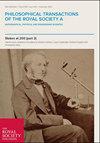Impact of a planar flexible bar with geometrical discontinuities of the first kind
Philosophical Transactions of the Royal Society of London. Series A, Mathematical and Physical Sciences
Pub Date : 2001-12-15
DOI:10.1098/rsta.2001.0910
引用次数: 1
Abstract
A model is presented for the impact of a multiple-angled flexible bar in planar motion. The model consists of a system of nonlinear differential equations that considers the multiple collisions as well as frictional effects at the contacting end, and allows one to predict the rigid and elastic body motion after the impact. The mode functions are selected such that the method can be made computationally as simple as possible, without compromising accuracy. To describe the impact between the elastic bar and the rigid surface, the classical Hertzian contact theory and elasto-plastic indentation theory are used. Particular emphasis is placed on the geometry of the bar because the unit tangent vector and the unit normal vector have first-order discontinuities. Analytical and experimental results are compared to establish the accuracy of the model.具有第一类几何不连续的平面柔性杆的冲击
建立了多角度柔性杆在平面运动中的冲击模型。该模型由考虑多次碰撞和接触端摩擦效应的非线性微分方程组组成,可以预测碰撞后的刚体和弹性体运动。模态函数的选择使得该方法在计算上尽可能简单,而不影响精度。采用经典赫兹接触理论和弹塑性压痕理论来描述弹性杆与刚性表面之间的碰撞。由于单位切矢量和单位法矢量具有一阶不连续,因此特别强调了棒材的几何形状。通过对分析结果和实验结果的比较,验证了模型的准确性。
本文章由计算机程序翻译,如有差异,请以英文原文为准。
求助全文
约1分钟内获得全文
求助全文
来源期刊
自引率
0.00%
发文量
0

 求助内容:
求助内容: 应助结果提醒方式:
应助结果提醒方式:


